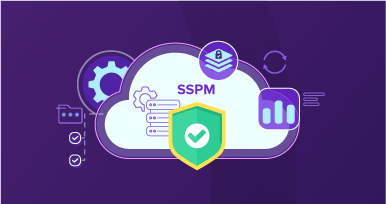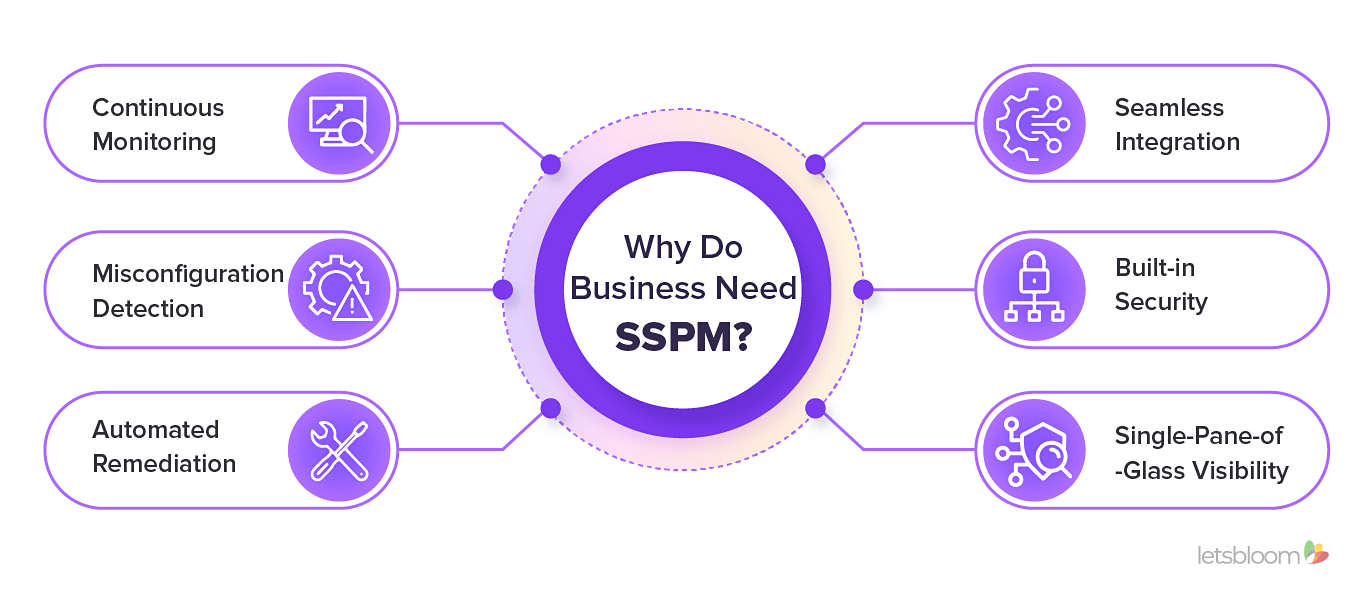What is SSPM: SaaS Security Posture Management?

Ritika Jain
Aug 20, 2024


With the growing adoption of cloud computing, organizations are increasingly relying on Software-as-a-Service (SaaS) applications to drive their operations. While this shift brings numerous benefits such as flexibility, scalability, and cost efficiency, it also introduces new security challenges.
As organizations integrate multiple SaaS applications into their ecosystems, maintaining a robust security posture across all these platforms becomes increasingly complex. This is where SaaS Security Posture Management (SSPM) plays a crucial role in simplifying, streamlining, and strengthening SaaS application security.
What is SaaS Security Posture Management?
SaaS Security Posture Management (SSPM) is a specialized cybersecurity solution designed to address the unique challenges posed by the widespread adoption of SaaS applications. SSPM provides organizations with comprehensive visibility into their SaaS ecosystems, enabling proactive identification of security gaps, misconfigurations, and compliance issues.
Unlike cloud security posture management (CSPM), which offers a holistic view of an organization's entire cloud infrastructure, SSPM focuses exclusively on SaaS applications like Salesforce, Slack, and Office 365. Organizations that primarily leverage SaaS, rather than cloud infrastructure like platform-as-a-service (PaaS) and serverless computing, may find SSPM more valuable than CSPM.
Understanding the Working of SSPM
SSPM solutions employ sophisticated techniques to analyze and secure an organization's SaaS applications in several key areas, including
- Configurations: SSPM scrutinizes security configurations across all SaaS applications, identifying errors or weaknesses that could expose sensitive data to unauthorized access or cyberattacks. This includes evaluating data storage practices, encryption protocols, and access controls.
- User Permission Settings: SSPM reviews user permissions and access rights within SaaS applications, detecting inactive or unnecessary user accounts that could be potential entry points for attackers. By eliminating unnecessary access rights, SSPM helps reduce the attack surface and minimize the impact of potential security breaches.
- Compliance: In today’s evolving landscape of data security and privacy regulations, SSPM ensures that an organization's SaaS applications adhere to relevant standards, such as GDPR, HIPAA, or PCI-DSS. It identifies security risks that may lead to non-compliance, helping organizations avoid costly fines and reputational damage.
Why Do Businesses Need SSPM?

Adopting SSPM offers several key benefits that strengthen an organization's security posture and improve overall operational efficiency
- Continuous Monitoring: SSPM solutions provide continuous, comprehensive, real-time monitoring of SaaS applications, ensuring that potential security gaps are identified and addressed promptly. This reduces the window of opportunity for attackers and enhances overall cyber resilience.
- Misconfiguration Detection: Misconfigurations are a leading cause of data breaches in cloud environments. SSPM identifies these issues and provides timely alerts to security personnel for rapid remediation.
- Automated Remediation: SSPM solutions offer automated remediation capabilities, enabling organizations to respond swiftly and effectively to security threats. This automation reduces the burden on IT teams, allowing them to focus on strategic tasks rather than manual issue resolution.
- Seamless Integration: SSPM solutions integrate seamlessly with a wide range of SaaS tools, ensuring comprehensive security coverage across the entire SaaS ecosystem.
- Built-in Security: SSPM solutions are built upon leading industry standards and regulatory benchmarks, enabling organizations to align their security postures with best practices. SSPM continuously evaluates the security configurations of SaaS applications against established security policies and industry benchmarks including CIS, PCI-DSS, NIST, HIPAA, CSA, GDPR, and ISO. This enables organizations to maintain a robust security posture and stay ahead of emerging threats.
- Single-Pane-of-Glass Visibility: One of the key advantages of SSPM is its ability to provide a consolidated view of an organization's security posture across all SaaS applications. This single-pane-of-glass visibility simplifies the process of identifying and addressing security risks, ensuring that all stakeholders have a unified understanding of the organization’s security status.
NIS2 & DORA – Are You Cyber-ready?
Download this eBook for insightful tips to ensure your organization operates with unwavering resilience.
How Does letsbloom Help Organizations Secure Their SaaS Applications?
letsbloom enables organizations of all sizes and industries to build, test, deploy, and run future-ready, fail-proof SaaS applications in any cloud, with security and compliance embedded throughout the application development lifecycle.
Our multi-cloud compliance automation platform works well with any cloud (including AWS, Azure, and GCP) and any workload (Infrastructure as code, Kubernetes workloads, and containers) and any regulation and standard (including CIS, NIST, MAS, ISO, SOC 2, PCI DSS, DFSA, NYDFS, HIPAA, DORA, and GDPR).
Partner with letsbloom today to build secure and compliant SaaS apps! Request a FREE demo!










